1st Infantry Division Artillery (United States)
The 1st Infantry Division Artillery (DIVARTY) is the divisional artillery command and force fires headquarters for the 1st Infantry Division at Fort Riley, Kansas. The DIVARTY has served with the division from 1917–1939, 1940–1995, 1996–2005, and reactivated in October 2015. The unit has been stationed at Fort Riley, Kansas, and in Germany, and has seen combat in World War I, World War II, the Vietnam War, Operation Desert Storm, and Operation Iraqi Freedom. The DIVARTY provides a single proponent with the division for standardized fires certification and leader development while exemplifying effective mission command, and supporting the seamless cross-attachment of units with common procedures and a shared understanding of the fires warfighting capabilities.
| 1st Infantry Division Artillery | |
|---|---|
 Distinctive unit insignia | |
| Active | 1917–1939 1940–1995 1996–2005 2015 – present |
| Country | |
| Branch | |
| Type | |
| Role | Division force fires HQ |
| Size | Brigade |
| Part of | 1st Infantry Division |
| Garrison/HQ | Fort Riley, Kansas |
| Nickname(s) | "Drumfire" |
| Equipment | M109A6 howitzer |
| Engagements | World War I World War II Vietnam War Operation Desert Storm Operation Iraqi Freedom |
| Commanders | |
| Current commander | Col. Timothy R. Mungie |
| Command Sergeant Major | CSM Jose Barajas |
| Notable commanders | MG John Shirley Wood, 1940–41 MG Richard Longo, 2003–05 |
History
World War I

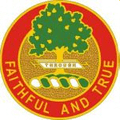
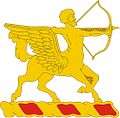


Interwar
On 7 October 1920, the 1st Field Artillery Brigade organized under the peacetime TO&E, which included two light (75mm) regiments, and ammunition train of battalion size and a medical detachment. In 1929, the medium (155mm) regiment returned to the brigade. Due to budgetary constraints, none of the units were manned or equipped to wartime strength. [2] The 1st Division adopted a new peacetime TO&E in preparation for war on 8 January 1940, which included one light field artillery regiment of three battalions and one medium field artillery regiment of two battalions. The 1st Infantry Division reorganized again on 1 November 1940 to a new TO&E, which reorganized the Artillery Brigade into a division artillery command led by a brigadier general with one medium and three light field artillery battalions.
World War II



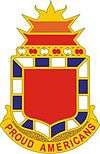

Vietnam War




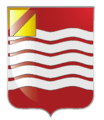

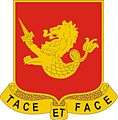
Global War on Terror



Lineage & honors
Lineage
- Constituted 24 May 1917 in the Regular Army as Headquarters, 1st Field Artillery Brigade, and assigned to the 1st Expeditionary Division
- Partially organized in June 1917 at Washington, D.C.; organization completed in August 1917 in France
- Disbanded 16 October 1939 at Fort Hoyle, Maryland
- Reconstituted 10 September 1940 in the Regular Army as Headquarters and Headquarters Battery, 1st Division Artillery
- Activated 1 October 1940 at Madison Barracks, New York
- Reorganized and redesignated 15 February 1957 as Headquarters and Headquarters Battery, 1st Infantry Division Artillery
- Inactivated 15 November 1995 at Fort Riley, Kansas
- Activated 16 February 1996 in Germany[5]
- Inactivated 15 February 2006 in Germany[6]
- Activated 16 October 2015 at Fort Riley, Kansas[7]
Campaign credit
| Conflict | Streamer | Year(s) |
|---|---|---|
| World War I |
Montdidier-Noyon | 1918 |
| Aisne-Marne | 1918 | |
| Saint-Mihiel | 1918 | |
| Meuse-Argonne | 1918 | |
| Lorraine 1917 | 1917 | |
| Lorraine 1918 | 1918 | |
| Picardy 1918 | 1918 | |
| World War II |
Algeria-French Morocco (with arrowhead) | 1942 |
| Tunisia | 1942 | |
| Sicily (with arrowhead) | 1943 | |
| Normandy (with arrowhead) | 1944 | |
| Northern France | 1944 | |
| Rhineland | 1945 | |
| Ardennes-Alsace | 1944–1945 | |
| Central Europe | 1945 | |
| Vietnam War |
Defense | 1965 |
| Counteroffensive | 1965–1966 | |
| Counteroffensive, Phase II | 1966–1967 | |
| Counteroffensive, Phase III | 1967–1968 | |
| Tet Counteroffensive | 1968 | |
| Counteroffensive, Phase IV | 1968 | |
| Counteroffensive, Phase V | 1968 | |
| Counteroffensive, Phase VI | 1968–1969 | |
| Tet 69/Counteroffensive | 1969 | |
| Summer-Fall 1969 | 1969 | |
| Winter-Spring 1970 | 1969–1970 | |
| Gulf War |
Defense of Saudi Arabia | 1990–1991 |
| Liberation and Defense of Kuwait | 1991 | |
| Ceasefire | 1991 | |
| Global War On Terrorism |
Global War on Terrorism | 2001–present |
| Operation Iraqi Freedom |
Iraqi Governance | 2004 |
| National Resolution | 2005 | |
Decorations
| Ribbon | Award | Year | Notes |
|---|---|---|---|
| Meritorious Unit Commendation (Army) | VIETNAM 1968 | ||
| Meritorious Unit Commendation (Army) | SOUTHWEST ASIA | ||
| Army Superior Unit Award (Army) | 1997 | ||
| French Croix de Guerre, with Palm | KASSERINE | ||
| French Croix de Guerre, with Palm | NORMANDY | ||
| French Croix de Guerre, World War II, Fourragere | |||
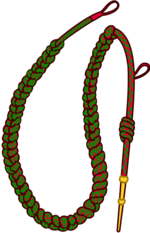 |
Belgian Fourragere | 1940 | |
| Cited in the Order of the Day of the Belgian Army | For action at MONS | ||
| Cited in the Order of the Day of the Belgian Army | For action at EUPEN-MALMEDY | ||
| Republic of Vietnam Cross of Gallantry, with Palm | 1965–1968 | For service in Vietnam | |
| Republic of Vietnam Civil Action Unit Citation | 1965–1970 | For service in Vietnam |
Distinctive unit insignia

- Description/blazon: A red increscent with the human portion of a centaur issuant with drawn bow and arrow all in gold partially superimposed and between the cusps of the increscent. The insignia is 1 3/32 inches (2.78 cm) in width
- Symbolism: The 1st Field Artillery Brigade had in its organization the 6th and 7th Field Artillery Regiments and the badge consists of a charge from the shield of the coat of arms of the 7th Field Artillery and a portion of the crest of the 6th Field Artillery Regiment, to show the brigade's connection with these units
- Background: The distinctive unit insignia was originally approved for the 1st Field Artillery Brigade on 17 August 1928. It was redesignated for Headquarters and Headquarters Battery, 1st Infantry Division Artillery on 28 December 1954.[8]
References
- ORDER OF BATTLE OF THE UNITED STATES LAND FORCES IN THE WORLD WAR p2
- The US Army Order of Battle from 1919-1941 p697-703
- Stanton, Shelby L. (1984). World War II Order of Battle. New York, New York: Galahad Books.
- Stanton, Shelby L. (1984). Vietnam Order of Battle. New York, New York: Galahad Books.
- "Lineage and Honors Information: Headquarters and Headquarters Battery, 1st Infantry Division Artillery." U.S. Army Center for Military History. 24 September 1996. Web. Accessed 16 November 2015. <http://www.history.army.mil/html/forcestruc/lineages/branches/div/001ida.htm>.

- Robson, Seth. "1st ID's Division Artillery is inactivated." Stars and Stripes. 17 February 2006. Web. Accessed 16 November 2015. <http://www.stripes.com/news/1st-id-s-division-artillery-is-inactivated-1.45051>.
- "Division Artillery returns to 'Big Red One': unit's activation set for Oct. 16." www.army.mil: The Official Homepage of the United States Army. 6 October 2015. Web. Accessed 16 November 2015. <http://www.stripes.com/news/1st-id-s-division-artillery-is-inactivated-1.45051>.
- "1st Infantry Division Artillery." The Institute of Heraldry. n.d. Web. Accessed 16 November 2015. <http://www.tioh.hqda.pentagon.mil/Catalog/Heraldry.aspx?HeraldryId=5332&CategoryId=3038&grp=2&menu=Uniformed%20Services>.
